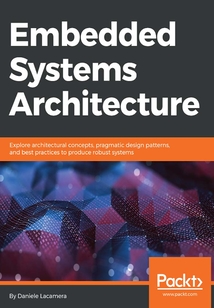舉報(bào) 

會(huì)員
Embedded Systems Architecture
Ifyou’reasoftwaredeveloperordesignerwantingtolearnaboutembeddedprogramming,thisisthebookforyou.You’llalsofindthisbookusefulifyou’realessexperiencedembeddedprogrammerwillingtoexpandyourknowledge.
目錄(232章)
倒序
- 封面
- 版權(quán)信息
- Packt Upsell
- Why subscribe?
- PacktPub.com
- Contributors
- About the author
- About the reviewer
- Packt is searching for authors like you
- Preface
- Who this book is for
- What this book covers
- To get the most out of this book
- Download the example code files
- Download the color images
- Conventions used
- Get in touch
- Reviews
- Embedded Systems – A Pragmatic Approach
- Domain definition
- Embedded Linux systems
- Low-end 8-bit microcontrollers
- Hardware architecture
- Understanding the challenge
- Multithreading
- RAM
- Flash memory
- Interfaces and peripherals
- Asynchronous UART-based serial communication
- SPI
- I2C
- USB
- Connected systems
- The reference platform
- ARM reference design
- The Cortex-M microprocessor
- Summary
- Work Environment and Workflow Optimization
- Workflow overview
- C compiler
- Linker
- Build automation
- Debugger
- Embedded workflow
- The GCC toolchain
- The cross-compiler
- Compiling the compiler
- Linking the executable
- Binary format conversion
- Interacting with the target
- The GDB session
- Validation
- Functional tests
- Hardware tools
- Testing off-target
- Emulators
- Summary
- Architectural Patterns
- Configuration management
- Revision control
- Tracking activities
- Code reviews
- Continuous integration
- Source code organization
- Hardware abstraction
- Middleware
- Application code
- The life cycle of an embedded project
- Defining project steps
- Prototyping
- Refactoring
- API and documentation
- Summary
- The Boot-Up Procedure
- The interrupt vector table
- Startup code
- Reset handler
- Allocating the stack
- Fault handlers
- Memory layout
- Building and running the boot code
- The makefile
- Running the application
- Multiple boot stages
- Bootloader
- Building the image
- Debugging a multi-stage system
- Shared libraries
- Summary
- Memory Management
- Memory mapping
- Memory model and address space
- The code region
- The RAM regions
- Peripheral-access regions
- The system region
- Order of memory transactions
- The execution stack
- Stack placement
- Stack overflows
- Stack painting
- Heap management
- Custom implementation
- Using newlib
- Limiting the heap
- Multiple memory pools
- Common heap usage errors
- The memory protection unit
- MPU configuration registers
- Programming the MPU
- Summary
- General-Purpose Peripherals
- The interrupt controller
- Peripherals interrupt configuration
- System time
- Adjusting the flash wait states
- Clock configuration
- Clock distribution
- Enabling the SysTick
- Generic timers
- General-purpose I/O
- Pin configuration
- Digital output
- PWM
- Digital input
- Interrupt-based input
- Analog input
- The watchdog
- Summary
- Local Bus Interfaces
- Introducing serial communication
- Clock and symbol synchronization
- Bus wiring
- Programming the peripherals
- UART-based asynchronous serial bus
- Protocol description
- Programming the controller
- Hello world!
- Newlib printf
- Receiving data
- Interrupt-based input/output
- SPI bus
- Protocol description
- Programming the transceiver
- SPI transactions
- Interrupt-based SPI transfers
- I2C bus
- Protocol description
- Clock stretching
- Multi-master
- Programming the controller
- Interrupt handling
- Summary
- Low-Power Optimizations
- System configuration
- Hardware design
- Clock management
- Voltage control
- Low-power operating modes
- Deep-sleep configuration
- Stop mode
- Standby mode
- Wake-up intervals
- Measuring power
- Development boards
- Designing low-power embedded applications
- Replacing busy loops with sleep mode
- Deep sleep during longer inactivity periods
- Choosing the clock speed
- Power state transitions
- Summary
- Distributed Systems and IoT Architecture
- Network interfaces
- Media Access Control
- Ethernet
- Wi-Fi
- Low-Rate Wireless Personal Area Networks (LR-WPAN)
- LR-WPAN industrial link-layer extensions
- 6LoWPAN
- Bluetooth
- Mobile networks
- Low-power Wide Area Networks (LPWANs)
- Selecting the appropriate network interfaces
- The Internet Protocols
- TCP/IP implementations
- Network device drivers
- Running the TCP/IP stack
- Socket communication
- Mesh networks and dynamic routing
- Transport Layer Security
- Securing socket communication
- Application protocols
- Message protocols
- REST architectural pattern
- Distributed systems – single points of failure
- Summary
- Parallel Tasks and Scheduling
- Task management
- The task block
- Context switch
- Creating tasks
- Scheduler implementation
- Supervisor calls
- Cooperative scheduler
- Concurrency and timeslices
- Blocking tasks
- Waiting for resources
- Real-time scheduling
- Synchronization
- Semaphore
- Mutex
- Priority inversion
- System resource separation
- Privilege levels
- Memory segmentation
- System calls
- Summary
- Embedded Operating Systems
- Real-time application platforms
- FreeRTOS
- ChibiOS
- Low-power IoT systems
- Contiki OS
- Riot OS
- POSIX-compliant systems
- NuttX
- Frosted
- The future of safe embedded systems
- Process isolation – Tock
- Summary
- Other Books You May Enjoy
- Leave a review - let other readers know what you think 更新時(shí)間:2021-06-25 21:55:35
推薦閱讀
- 零起點(diǎn)學(xué)Linux系統(tǒng)管理
- Kali Linux滲透測(cè)試全流程詳解
- Persistence in PHP with the Doctrine ORM
- 操作系統(tǒng)基礎(chǔ)與實(shí)踐:基于openEuler平臺(tái)
- 嵌入式Linux系統(tǒng)開(kāi)發(fā):基于Yocto Project
- 曝光:Linux企業(yè)運(yùn)維實(shí)戰(zhàn)
- 精通Linux內(nèi)核開(kāi)發(fā)
- Python基礎(chǔ)教程(第3版)
- Instant Optimizing Embedded Systems using Busybox
- 網(wǎng)絡(luò)操作系統(tǒng)管理與應(yīng)用(第三版)
- Linux使用和管理指南:從云原生到可觀測(cè)性
- 8051軟核處理器設(shè)計(jì)實(shí)戰(zhàn)
- Learning Bootstrap
- 巧學(xué)活用Windows 7
- AWS Development Essentials
- ElasticSearch Cookbook
- Windows 10從新手到高手
- Linux軟件管理平臺(tái)設(shè)計(jì)與實(shí)現(xiàn)
- 鴻蒙操作系統(tǒng)設(shè)計(jì)原理與架構(gòu)
- Hadoop Operations and Cluster Management Cookbook
- 深入理解Android:卷III
- Embedded Systems Architecture
- Instant XenMobile MDM
- Red Hat Enterprise Linux 8.0 系統(tǒng)運(yùn)維管理
- Linux C編程80例詳解
- React Native Blueprints
- 輕松學(xué)家庭電腦應(yīng)用
- Kubernetes微服務(wù)實(shí)戰(zhàn)
- DevOps for Serverless Applications
- Linux系統(tǒng)管理與服務(wù)配置實(shí)戰(zhàn)(慕課版)

